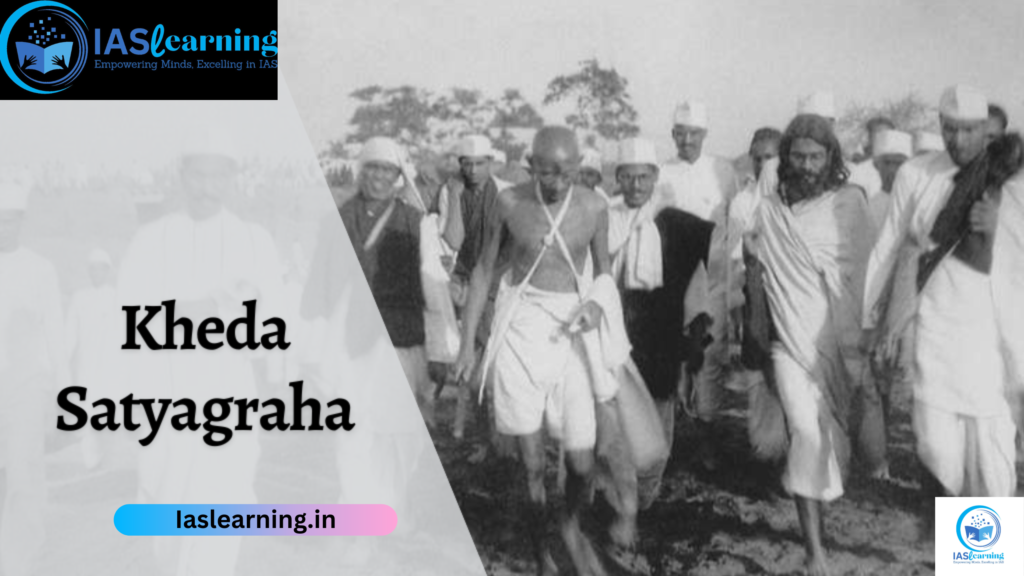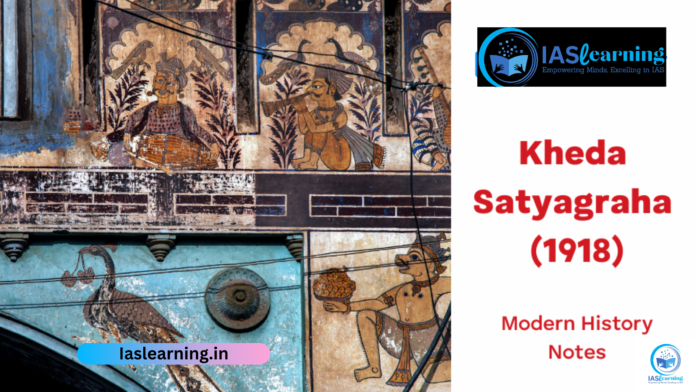Kheda Satyagraha (1918)
On March 11, 1918, the Kheda Satyagraha was started in Gujarat’s Kheda District (which was then part of Bombay province). With the aid of local leader Mohanlal Pandya, the peasants initiated the movement at the beginning. It primarily included the Kheda Peasant-Patidar group, which subsequently engaged Gandhi’s leadership. Their demand was the non-payment of money in light of the government’s callous hike in the tax rate, the loss of the crop, and market price increases.
Gandhi’s political career in India began with the Kheda Satyagraha, which is widely seen as the turning point for his rise to popularity as a mass leader in the freedom movement, along with Champaran Satyagraha and the Ahmedabad Mill Strike. Gandhi initially embraced a non-cooperation campaign in India with the Kheda Satyagraha.
For more : Ahmedabad Mill Strike: First Hunger Strike,1918

Reasons for Kheda Satyagraha
During World War I, the cost of essential goods increased. In light of this, the following circumstances made the suffering of the residents of Kheda District worse and ultimately led to the beginning of the Kheda Satyagraha.
- Poor crop: The price increase for essentials corresponded with a poor harvest in 1917–18.
- Plague: In 1918, Gujarat was severely affected by the deadly plague, which claimed 16,740 deaths in Kheda alone.
- The peasant-Patidar community declined to pay the increased taxes for these reasons.
- Tax increase: Between 1917 and 1918, the British government raised taxes by 23% in the Bombay Presidency, which included Gujarat.
- Refusal of the petition: To lessen their hardship, the peasants petitioned the colonial authorities in 1918 for a one-year decrease in land revenue.
- Despite the fact that it was against the starvation code of the government, the authorities rejected and demanded full payment.
- Under the Code, growers were eligible for full remission in the event that crop output was less than 25% of the average.
- Additionally, if the harvest was four annas or less, producers might ask for a full suspension of income payment for the whole year, according the Land income Rules.
For more : What is the concept of Nation and State?
What is Constitutionalism And Consitutional Morality
The Action Strategy for the Kheda Satyagraha
Local leaders like Mohanlal Pandya spearheaded the no-revenue movement in November 1917 in reaction to the petition’s rejection.
No-profit initiative
- Local leaders’ role: Mohanlal Pandya and Shankarlal Parikh asked for assistance from external leaders, especially the Gujarat Sabha members in Ahmedabad.
- They also telegraphed Gandhi, who was in Champaran at the time, requesting assistance. Gandhi could not physically attend, but he urged them to press their demands.
- The Gujarat Sabha, led by Gandhi, played a crucial role in pressuring the Bombay administration to provide exemptions in certain circumstances and to defer income obligations.
- The Sabha requested the peasants not to pay land revenues, but they did not receive a positive reaction.
Role of Gandhi in Kheda Satyagraha
- Gandhi decided to personally look into the dire situation of the peasants on his arrival in Bombay in February 1918. When Gandhi and other members of the Gujarat Sabha visited the villages in Kheda, they found evidence supporting the peasants’ demand to halt income collection.
Gandhi made the decision to use satyagraha at a Gujarat Sabha meeting after receiving no guarantee from the government about the demands of the peasants. - Gandhi asked the volunteers to make a holy vow at a meeting held in Nadiad on March 22, 1918, which was to not pay the annual assessment, in full or in part.
- Gandhi encouraged Satyagrahis to keep the commitment when he personally visited the villages of Kheda. Pandya, along with other local leaders, received a lot of support from the people despite being arrested for opposing the government.
Towards the End
- Government inquiry: The government conducted an inquiry and found no basis for the income suspension.
- Peasant unhappiness and their agitation for a postponement of income demands were made public by the local press.
- Political Leadership: Vallabhbhai Patel led a group of other committed Gandhians who traveled across the villages to organize the villagers, gave them instructions, and supplied the essential political leadership, along with Narahari Parikh, Mohanlal Pandya, and Ravi Shankar Vyas.
- Fulfillment of demand: Gandhi’s declared belief in passive resistance gave the authorities confidence that he would not use violence.
- The requirement for Indian assistance in the British war effort worried the administration almost as much.
- As a result, the government gave its local authorities instructions to exercise caution when collecting taxes and refrain from seizing land.
- Gandhi chose to put an end to the Satyagraha even though the administration had not given him many concrete assurances.
For more : American Revolution 1776, History, Causes, Timeline and its Impacts
History of the World Before 18th Century
Results of the Kheda Satyagraha
A significant turning point in the Indian independence struggle occurred in 1918 with the Kheda Satyagraha. Gandhi’s standing as an Indian national leader was furthered by it. The Satyagraha produced significant results, including
- The peasantry was not subject to land confiscation or revenue collection by the government.
- Only those who could afford it were subject to the land tax.
- Everyone’s help was also needed to return the property to the rightful owners of the confiscated land.
- Gandhi made the decision to give up the struggle even though the peasants did not get all they wanted.
Significance of the Kheda Satyagraha
Even though the Kheda Satyagraha was unable to satisfy every demand made by the peasants, it is nonetheless regarded as a noteworthy development in the history of the liberation fight. Some of the Kheda Satyagraha’s significance are listed below.
- The first movement against cooperation was the Kheda Satyagraha, which was organized by people of all ages. It ushered in the mass-movement period, together with the Champaran Satyagraha and the Ahmedabad Mill Strike.
- The Kheda campaign played a significant role in the strong development of Satyagraha in Gujarat.
- Villages in Kheda developed as a vital source of support for the nationalist cause as it progressed.
- Kheda emphasized Champaran’s teaching that satyagraha may be used in nearly every conflict scenario by individuals with or without literacy.

